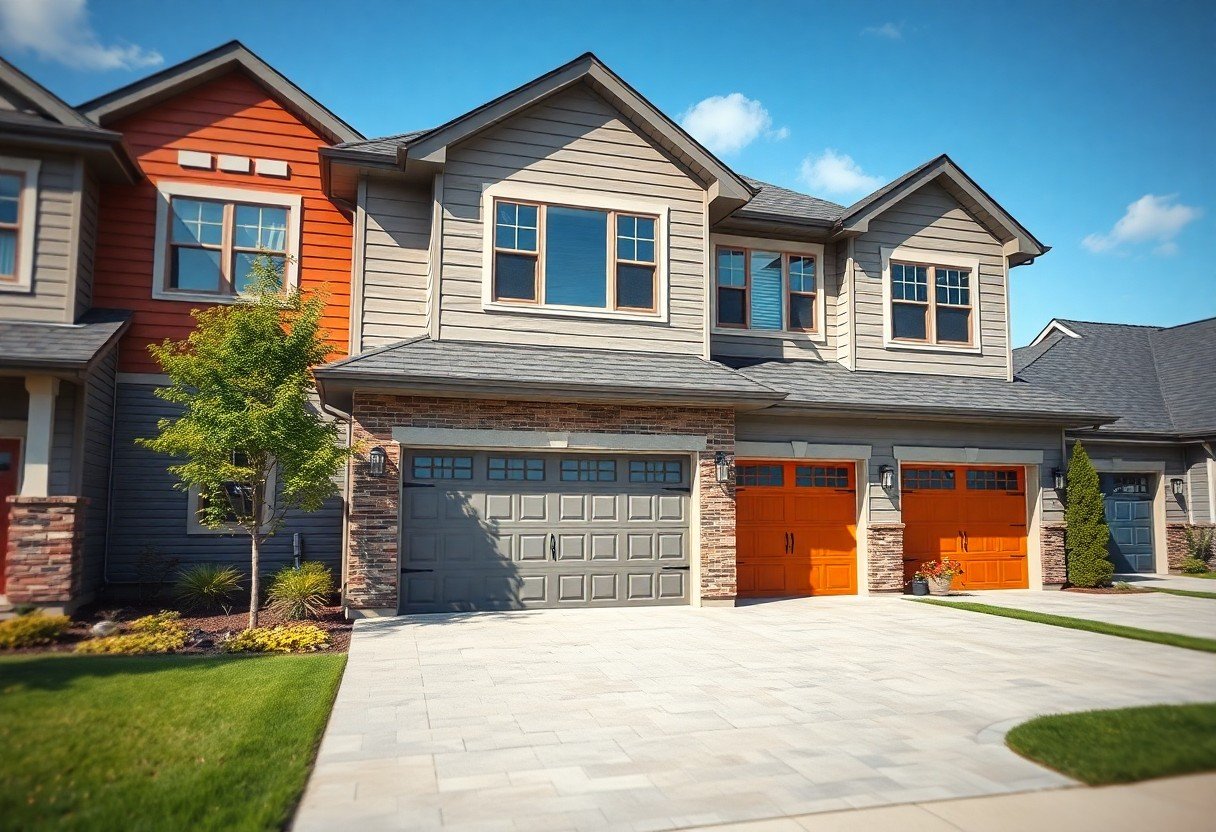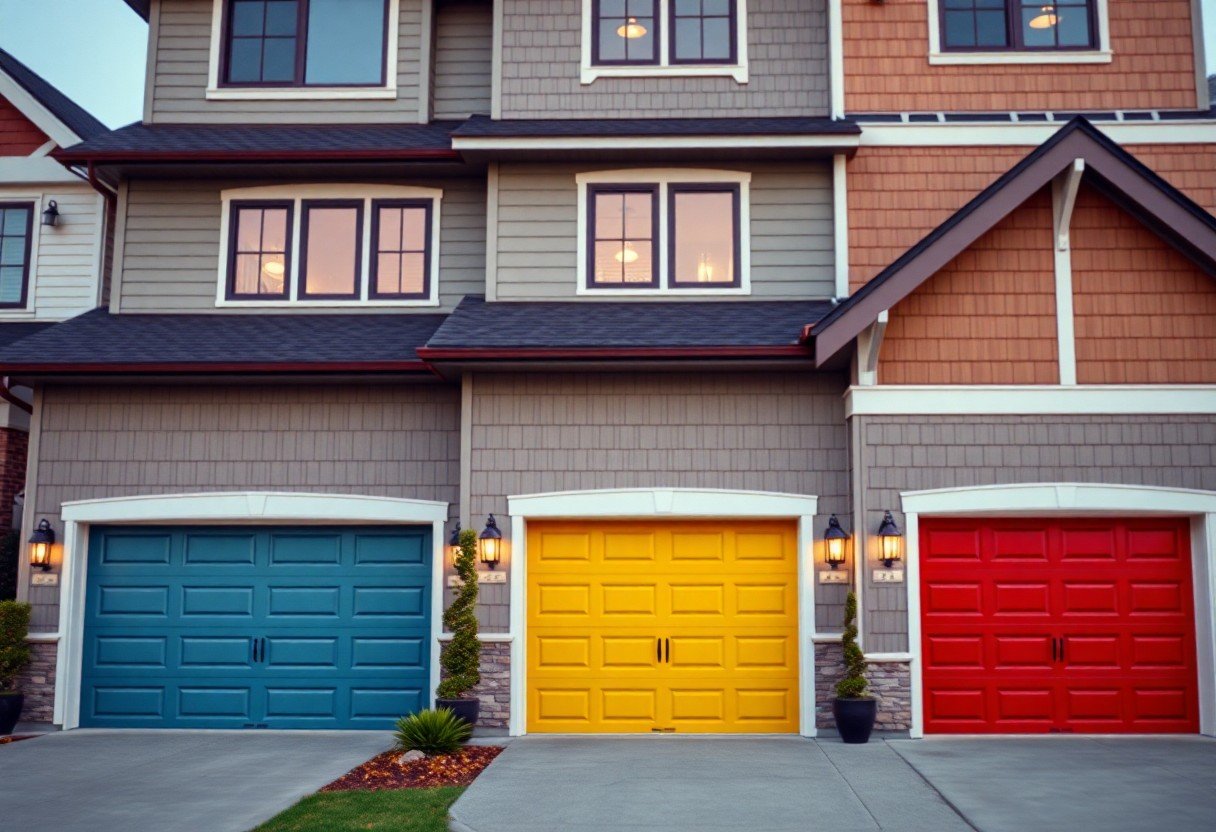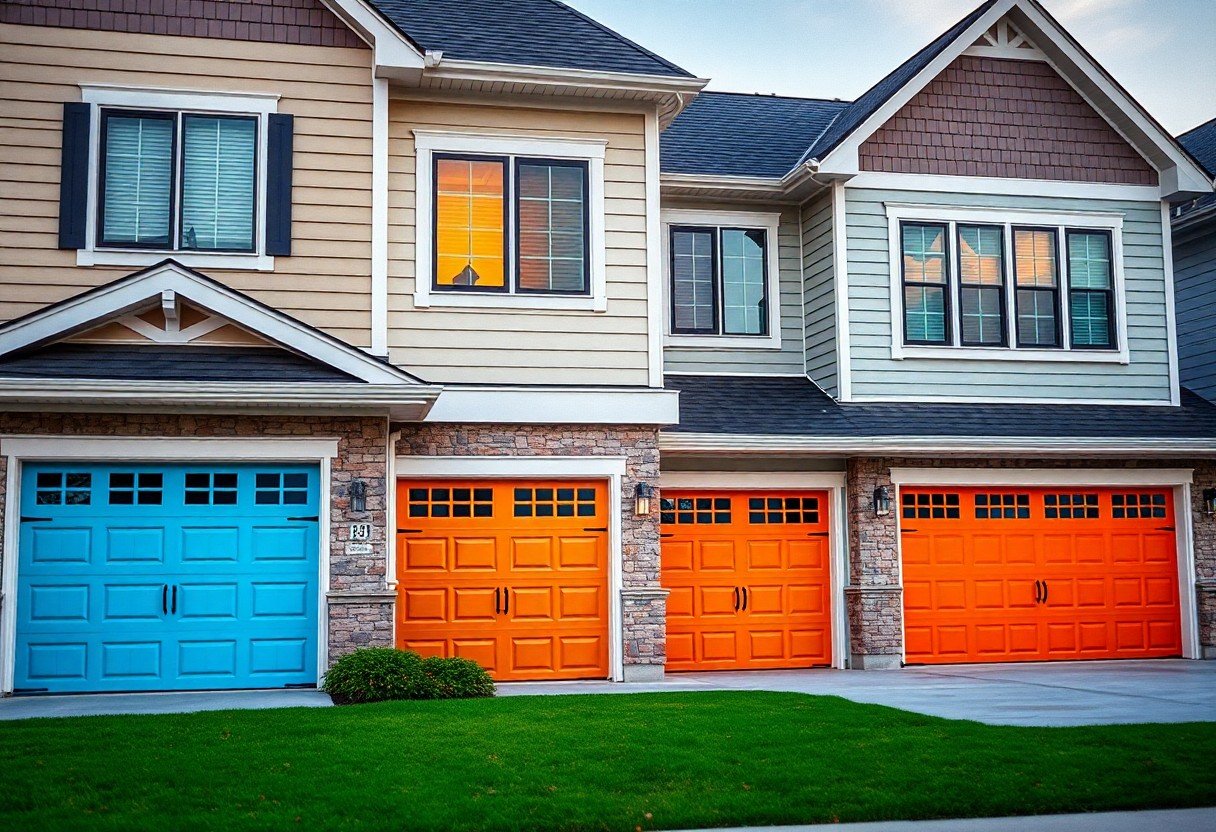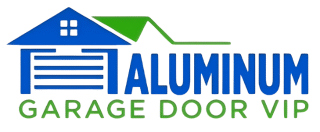
Choosing a Garage Door Color That Matches Your Home Design
Many homeowners underestimate the importance of selecting the right garage door color that complements their home design. Your garage door is a significant element of your home’s exterior, and its color can enhance or detract from your overall aesthetic. In this guide, you will learn key considerations to keep in mind when choosing a color that aligns with your personal style and architectural features, ensuring it seamlessly integrates into your home’s curb appeal.
Key Takeaways:
- Consider your home’s architectural style when selecting a garage door color to ensure a cohesive and harmonious look.
- Choose colors that complement other exterior elements, such as trim, shutters, and landscaping, to enhance your home’s overall aesthetic.
- Utilize color swatches and samples to visualize how different shades will appear in various lighting conditions before making a final choice.

Architectural Harmony: Aligning Garage Door Colors with Home Design
The Role of Architectural Style in Color Selection
Your home’s architectural style heavily influences which garage door colors look best. For instance, traditional homes often pair well with muted hues, while modern designs embrace bold colors to create striking contrasts. Mediterranean styles may lean towards earth tones, whereas Victorian architecture can accommodate richer, deeper shades. Understanding these dynamics allows you to make informed decisions that enhance your home’s aesthetic appeal.
Mocha Meets Modern: Case Studies in Color Compatibility
The synergy between a garage door color and the overall exterior design can significantly elevate your home’s visual presence. For instance, a modern home with large glass features might look stunning with a mocha garage door, providing warmth against cooler tones. Here are some case studies illustrating how color compatibility can transform your home:
- Case Study 1: A modern home in Chicago combined a deep blue facade with a light mocha garage door, increasing curb appeal by approximately 30% as noted in local real estate evaluations.
- Case Study 2: A Victorian home in San Francisco, where a creamy white garage door was paired with sage green siding, boosted its market value by 15%, according to neighborhood surveys.
- Case Study 3: A Mediterranean villa in Miami used terracotta for the garage door, perfectly complementing its coral stucco walls, resulting in a 25% faster sale compared to similar homes.
- Case Study 4: A contemporary style house in Seattle applied a charcoal black garage door against a cool gray structure, enhancing aesthetic uniformity and receiving favorable reviews from architecture critics.
These case studies exemplify how selecting a garage door color that aligns with your home’s architectural characteristics can lead to enhanced visual appeal and increased property value. Whether you prefer warm tones that invite or bold shades that stand out, there’s a color fit for your design. For more guidance on optimal color choices, check out Hints for tints – garage door colors made easy.

The Psychology of Color: How Shades Influence Perception
Warm vs. Cool Tones: What Your Choice Says About Your Home
Choosing warm tones, like reds and yellows, can create a sense of energy and friendliness in your home’s exterior, inviting guests and sparking joy. On the other hand, cool tones such as blues and greens tend to evoke calmness and tranquility, giving your home a serene presence. Each choice sends a distinct message about your personality and the atmosphere you wish to cultivate in your living space.
Creating Inviting Spaces: Color’s Impact on Curb Appeal
A well-chosen garage door color can significantly enhance your home’s curb appeal, drawing attention and admiration from passersby. This becomes especially vital during home sales, where first impressions matter. A striking, bold color can create a focal point that complements your landscape, while muted shades can harmonize with your home’s overall aesthetic. Ultimately, a thoughtful color scheme invites potential buyers to imagine themselves in your space, giving them a sense of belonging.
Consider the broader context when selecting your garage door color. For example, pairing a modern white door with sleek black accents can highlight contemporary design, making your home stand out in a cool way. In contrast, a soft sage green can enhance a rustic style, fitting beautifully within a garden-centric locale. This strategic approach not only amplifies your home’s visual appeal but also encourages the right emotional reaction from anyone who lays eyes on it. Make your choice reflective of your personal style while ensuring it aligns with the surrounding environment to achieve maximum impact.
Neighborhood Cohesion: Blending In or Standing Out?
Analyzing Local Trends: What Works in Your Area
Examining the color choices of garage doors in your neighborhood can provide insight into what resonates with your local aesthetic. Many areas tend to adopt a few popular colors that harmonize with the natural surroundings or architectural styles. For example, coastal communities may favor light blues and sandy neutrals, while suburban areas often see a prevalence of browns and greens. Surveying neighboring properties can guide you to make an informed yet stylish choice that fits your environment.
The Fine Line Between Unique and Jarring
Standing out with a distinctive garage door color can enhance individuality, but it risks clashing with the overall neighborhood vibe. Selecting a hue that’s too bold or inconsistent with your surrounding homes may lead to an unwelcoming appearance. It’s crucial to strike a balance between being unique and maintaining the character of your street. A bright yellow door may be eye-catching, but if your neighbors lean towards muted tones, it might create a visual disconnect that detracts from the neighborhood’s charm. Considering community standards not only ensures harmony but may also increase your home’s curb appeal and value.

Practical Considerations: Materials and Color Longevity
Durable Choices: Color Options That Withstand the Elements
Choosing a garage door color requires more than just aesthetics; it’s vital to consider durability. Darker shades can absorb more heat, which may lead to warping if you opt for less resilient materials. Look for colors that are applied with advanced finishes—these can resist fading caused by UV rays. Colors like deep greens and charcoal grays often have excellent longevity, especially when paired with steel or fiberglass materials that can handle extreme weather conditions.
Maintenance Matters: Selecting Shades That Require Less Upkeep
Opting for colors that minimize maintenance can keep your garage door looking fresh longer. Lighter shades tend to show dirt and wear more than mid-tone options. Choosing a hue that aligns with the environment and local weather can reduce the frequency of cleaning. For instance, sandy neutrals may camouflage dust better than stark whites. Additionally, some manufacturers offer specialized coatings that can enhance the durability of your chosen color, thus requiring less frequent upkeep.
In practical terms, selecting the right shade can lead to significant cost and time savings over the years. For example, if you choose a color that incorporates UV-resistant pigments, you could extend the lifespan of the paint by several years, reducing the need for repainting. Furthermore, light-to-medium shades paired with textured finishes can conceal minor scratches and dirt, which means less effort and fewer resources spent on maintenance. This consideration not only enhances the longevity of your garage door’s appearance but also aligns with a more sustainable and economical approach to home care.
Complementary Design Elements: Beyond the Garage Door
Integrating Door Color with Trim and Siding
Your garage door’s color should harmonize with the trim and siding of your home. Selecting a shade that echoes or complements these elements creates a cohesive look. For instance, if your trim is a crisp white, a deep navy or forest green door can provide a striking contrast while still feeling integrated. Alternatively, if your home features warmer hues like beige or taupe, a soft gray or muted cream in the garage door can enhance the overall aesthetic.
Landscaping and External Features: Creating a Unified Look
Landscaping plays a significant role in tying together your home’s exterior design, including your garage door. Incorporating similar colors from your door into your garden elements, such as flower pots or outdoor furniture, can establish a sense of continuity. Additionally, using materials like brick or stone that reflect the color of your garage door can further blend the structures into the surrounding environment, making a lasting impression.
To really elevate the aesthetic, consider using the same color palette found in your flower beds or hardscapes. For example, if your garage door is painted a warm taupe, choose plants with dusty greens or muted blossoms to enhance this shade. Utilize decorative features like trellises, railings, or even mailboxes that echo elements of the door color, turning your landscaping into a complementary backdrop that draws attention to the entire façade. By ensuring all external features harmonize with your garage door choice, you create a polished and inviting appearance that enhances your property’s curb appeal.
Personal Expression: Making Color Choices Reflect Your Style
Bold vs. Subdued: Translating Personality into Design
Your garage door is an excellent canvas for expressing your personality through color. Bold choices, such as vibrant yellows or deep blues, can convey a sense of fun and modernity, while subdued shades like soft greys or muted whites often project elegance and tranquility. Reflecting on your inclinations can guide you in selecting a shade that resonates with your unique style and sets the tone for your home’s overall aesthetic.
Seasonal Alterations: Flexible Options for Changing Tastes
Consider seasonal alterations as a means to refresh your home’s exterior and keep your garage door aligned with changing styles. Utilizing removable panels, vinyl wraps, or temporary paint can allow you to shift your garage door’s color as trends or your tastes evolve. This flexibility turns your door into a dynamic element of your property, accommodating your desire for change without the permanence of conventional painting methods.
Embracing seasonal alterations not only enhances your home’s curb appeal but also infuses your space with a sense of freshness. For example, warm tones evoke a cozy feeling during the fall, while pastel colors can lend a light, airy vibe in the spring. Certain products on the market allow for easy application and removal, such as peel-and-stick designs or spray-on coatings. By being open to alterations, you create a living space that continuously evolves with your preferences, making it a true reflection of your personal style.
Future Trends: What’s New in Garage Door Colors?
Innovative Trends in Aesthetic Appeal
Current trends are pushing the boundaries of garage door aesthetics, moving towards vibrant colors and unique finishes. Shades like deep teal, muted mustard, and even pastel tones are becoming popular, allowing you to enhance your home’s character. Moreover, textural elements such as wood grain finishes or metallic hues add depth and visual interest, providing a striking contrast to your home’s facade. Exploring creative combinations and unexpected color palettes can make your garage door a statement piece that complements your overall design, truly reflecting your individuality.
Predictions for the Next Decade: What to Expect
In the coming decade, expect the palette of garage door colors to become even more diverse and personalized. Homeowners are likely to gravitate toward colors that depict personal stories or local cultural influences, moving away from traditional choices. The integration of smart technology will also influence color selection, with options that can change hues or patterns based on your preference or the time of day.
The next decade will see advancements in paint technology, including eco-friendly options and color-changing coatings that respond to environmental factors. As you consider your garage door color, anticipate an emphasis on sustainability without sacrificing style. Features like solar-reflective finishes that adjust to temperature changes might gain popularity, reflecting a growing awareness of energy efficiency in design choices. Keeping an eye on these trends will not only enhance the curb appeal of your home but could also contribute to its overall value. For more insights, check out discussions around Garage Doors and Color Matching the House….
Final Words
Conclusively, selecting a garage door color that complements your home design enhances your property’s overall appeal. By considering your home’s architectural style, existing color palette, and personal preferences, you can create a cohesive look that elevates your home’s aesthetic. Don’t hesitate to experiment with different shades, but ensure they harmonize with the surroundings. Ultimately, the right color choice not only reflects your style but also adds value to your home, making it stand out in your neighborhood.
FAQ
Q: How do I choose a garage door color that complements my home’s exterior?
A: To find a garage door color that complements your home’s exterior, begin by analyzing the dominant colors in your facade, such as the siding, roofing, and trim. Consider selecting a color from the same color palette, such as neutral shades that can enhance architectural features. Alternatively, choose a contrasting color that makes a statement without overwhelming your home’s appearance. Testing paint samples next to your home can provide a visual reference before making a final decision.
Q: Are there specific color trends for garage doors that I should consider?
A: Yes, there are a variety of color trends for garage doors that can enhance modern home designs. Popular choices include shades like charcoal gray, deep blue, and warm earth tones that evoke natural materials. Additionally, bright hues such as red or teal can offer a fun touch, depending on your home style. Stay updated with design magazines or websites to see which colors are currently popular, but be sure to choose a shade that resonates with your personal taste and the overall aesthetic of your home.
Q: What role does the finish of a garage door color play in its appearance?
A: The finish of a garage door significantly affects how it appears in different lighting conditions. Matte finishes can provide a subtle and sophisticated look, while glossy finishes tend to reflect light and can brighten up the space. Additionally, the finish can impact maintenance; for instance, textured finishes may hide dirt and wear better than smooth ones. When opting for a color and finish, consider how they will work together with your home’s design and how much upkeep you are prepared to manage.



